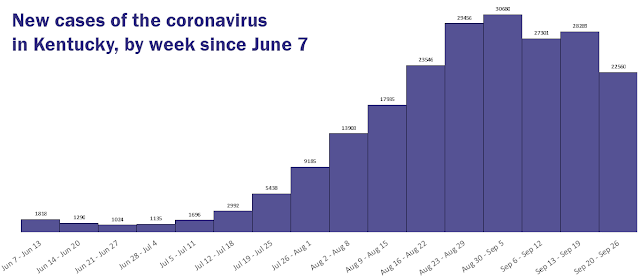Beshear asks Kentuckians not to unmask just because case numbers are dropping, warning that they are still way too high

State Dept. for Public Health graph, adapted by Ky. Health News; click on it to enlarge.
—–
By Melissa Patrick
Kentucky Health News
New-case numbers and the percentage of Kentuckians testing positive for the coronavirus declined last week, which Gov. Andy Beshear called a “good sign” while stressing cases are “way too high” and need to start decreasing faster. He also urged Kentuckians to not let down their guard.
“We’ve got to wear masks. Don’t starting taking it off because you see cases starting to trail,” Beshear said, noting that he can only encourage since the legislature took away his ability to impose a statewide mask mandate.
The state reported 87 more Covid-19 deaths since Saturday, with 19 of them reported on Monday. The death toll is now 8,579. Over the last week, the state has averaged 34 Covid-19 deaths per day.
After listing at least eight fatalities in their 30s and 40s over the weekend, Beshear said, “If you’re in your 30s or in your 40s or in your 20s or below, you do need to get vaccinated as quickly as possible.”
Hospitals are reporting a decline in Covid-19 patients, although numbers in the intensive-care units aren’t dropping as fast. Kentucky hospitals reported 2,045 Covid-19 patients on Monday, 617 in intensive care and 399 on mechanical ventilation.
The hospital-cases number was 166 fewer than Friday. It went down 49 Saturday, fell by 117 Sunday, then stayed the same Monday. ICU numbers dropped to 608 Saturday, but rose to 609 Sunday and to 617 Monday. Patients on mechanical ventilation were 30 fewer on Monday than on Friday.
Beshear said the state has 104 ICU beds available and 68 of the state’s 96 acute-care hospitals are reporting critical staffing shortages.
The share of Kentuckians testing positive for the virus in the past seven days dropped for the 19th straight day, to 10.55%
Covid-19 vaccinations: From March 1 to Sept. 22, 86.7% of coronavirus cases, 92.1% of Covid-19 hospitalizations and 84.6% of Covid-19 deaths in Kentucky have been among the unvaccinated or partially vaccinated, according to a news release.
Beshear cautioned that because the Delta variant is so much more contagious than earlier strains of the virus, we will need more than 70% of the population vaccinated to reach herd immunity.
At the Howard L. Bost Memorial Health Policy Forum last week, state Public Health Commissioner Steven Stack said the number of people needed to get vaccinated to reach “community immunity” is closer to 90%.
Bottom line, Beshear said, a lot more people need to get vaccinated, especially those between the ages of 12-29 since at this time about half of this age group remains unvaccinated.
The Washington Post reports that in the last week, an average of 14,577 doses per day of vaccine were given in Kentucky, a 37% increase over the week before that. That’s the highest this number has been since June 20.
Boosters: Beshear reviewed the federal guidance for those who are eligible for Pfizer-BioNTech booster shot six months after their second shot. They are individuals 65 and older; those living in long-term care facilities; people 19 to 64 with a medical condition that increases their risk of Covid-19 infection; and people 18 to 64 who are likely to get exposed at their place of work.
“If you are eligible, go get them,” he said. “There are plenty of vaccine doses out there.”
In addition, the governor said a third shot of the Pfizer or Moderna vaccine is available and recommended at least 28 days after the second shot for people who are immunocompromised.
“I am a survivor of childhood polio from before vaccines eradicated that disease here in our country and around the world. So I have been a lifelong champion of vaccinations,” McConell said in a news release. “Mountains of evidence tell us these shots are safe, effective, and dramatically shrink the odds of severe disease or death from Covid. Like I’ve been saying for months: These safe and effective vaccines are the way to defend ourselves and our families from this terrible virus. They’re also how we stay on offense against Covid as a country. All Americans should speak with their doctors and get vaccinated.”
Treatment: Beshear announced that the federal government was sending five monoclonal antibody injection teams to help provide these treatments to Kentuckians with severe Covid-19.
Today, a team arrived at Baptist Health Corbin; on Sept. 29, teams will arrive at Highlands ARH Regional Medical Center in Floyd County and Primary Care Centers of Eastern Kentucky; and on Oct 1, teams will arrive at Taylor Regional Hospital in Campbellsville and ARH Middlesboro. Each team will include two to four nurses and/or paramedics to assist with injections.Beshear said the state will launch a webpage Thursday to show the 50-plus locations where treatments can be found, meeting the legislature’s mandate that they be offered in each of the state’s 15 area development districts.
Beshear said the state is getting more of this treatment than was originally allocated, but it’s important to know that “there is not going to be enough” for everyone who needs it.

